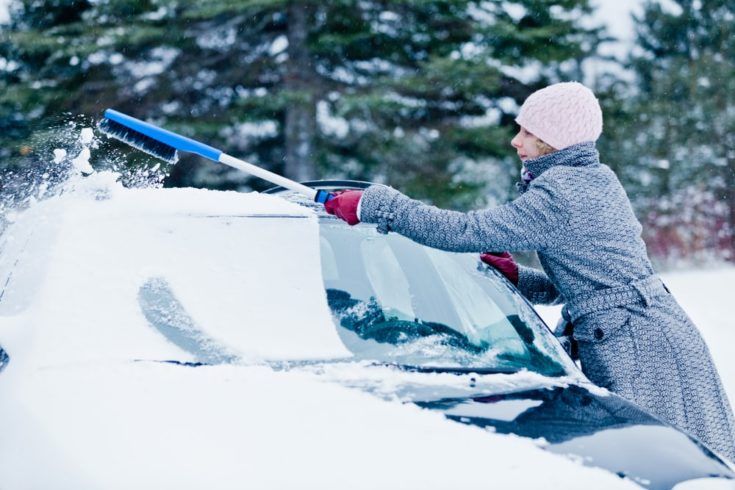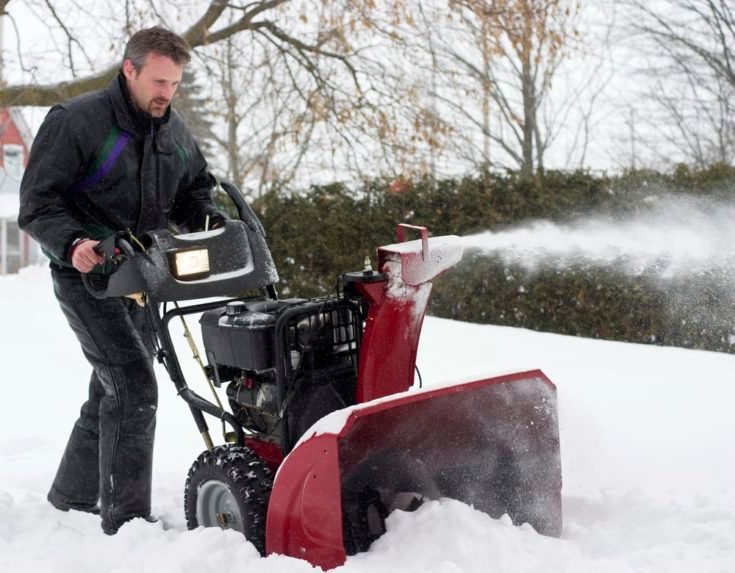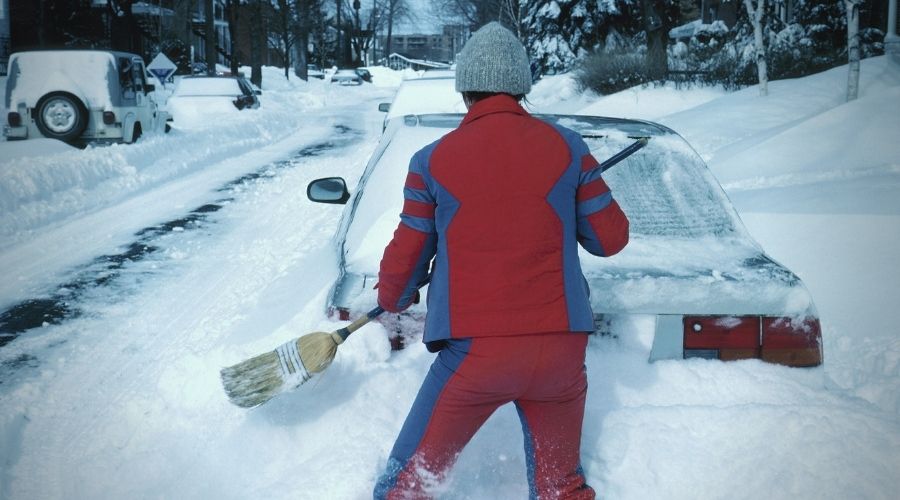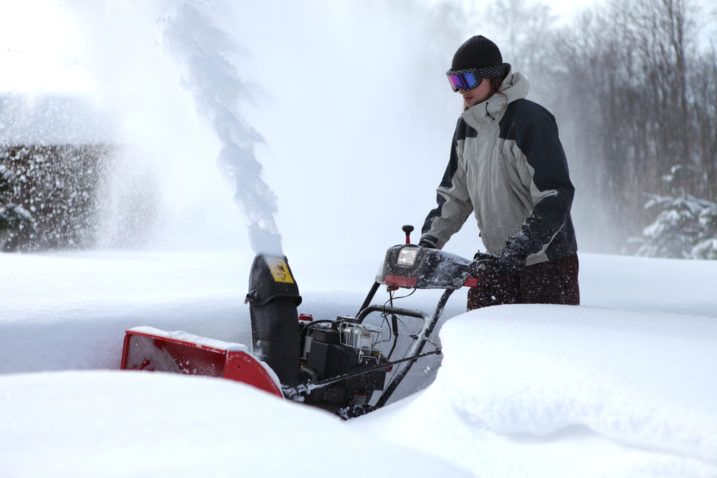If snowfall is a common occurrence where you live each winter, then you need to know you have a dependable product to help you keep your walkways and driveways clear from ice and snow. There are many tools you can turn to, but amongst the most effective is a snow blower, especially if you have snow falling regularly through the colder months.
Often overlooked is how helpful a power broom can be in the winter. These handheld products are powerful for year-long year maintenance and can make short work of snow falls- particularly in smaller, hard to reach areas. Read on to fully understand the differences between a power broom vs snowblower and where, and how, you might take advantage of them this winter.
|
Snow Broom |
Snowblower |
|---|---|

|

|
|
|
Handheld Power Brooms Explained
In order to clear up any confusion, this focus is on a handheld power broom, rather than a larger walk behind version which also goes by the names power brush or snow brush. These options are either gas or electric powered and are designed for year-round landscape maintenance. They are incredibly effective in clearing walkways and driveways of sand, dirt, snow, and leaves, as well as being able to be used on lawns to help clear out dry, dead grass from the winter. They also are highly effective on artificial lawns to keep dirt and debris from building up.
Created with durable bristles placed on a rotating cylinder, these also are excellent for clearing harder to reach areas, such as decking, patios, and garden paths in the winter. Snowblowers are rarely small enough to use on these types of areas, and a shovel can be awkward and still leave snow in the crack and crevices which can then melt and refreeze- creating hazardous issues.
Pros
- Multi-Seasonal
- Easy to carry to get into hard to reach places
- Works well on patios and decks
Cons
- Not for heavy, wet snowfalls
- Isn’t effective in deep snow
Types of Handheld Power Brooms
A handheld power broom is designed to run from a gas-powered engine or an electric cord. Very few battery operated brooms exist- however with advances in technology and battery life there is an expectation to see more model options made available. These are very versatile, and you can see how easy they are to use for winter purposes here:
- 2 Cycle Handheld
These options are the most common and can be found as a tool, or as an additional attachment to existing string trimmer models. Run from a powerful 2-cycle (or 2-stroke) engine the compact design can be used in a variety of situations. The engine is simple in design and requires some basic maintenance as well as a proper gas and oil mixture for lubrication purposes. With either a long-handled or dual-handled, design, you have a lot of control to put the broom into the areas you need it. These are especially nice for brick driveways and walkways to showcase your patterns.
- Electric Powered
Although not as popular due to the constraints of the extension cord you need to use, these models have a tendency to be slightly smaller in size for easier mobility. Created with a one handled design, the smaller width and lighter body make these easy to bring up on your decks, stairs, and lift from one surface to another. You also have very little maintenance other than keeping clean due to its direct draw from a standard electrical outlet.
Snow Broom Uses
As mentioned, handheld power brooms are versatile for all seasonal use. Gentle enough for lawns, but powerful enough for hard surfaces, you can keep a clean, well-manicured look to your landscape with very little effort. This use makes it easy to justify the cost, plus, you don't have to keep it stored and maintained through the warmer months.
See it in all season action here:
Efficiency
In terms of use for snow removal, they are most efficient in light or moderate snowfalls, and only when it is lighter, less packed snow. The fast rotation of the brush is effective in brushing and blowing the snow forward and away from the machine - but you are not at able to pile it up. You may also not be able to use it well in icy, wet, or heavy packed snow. These also are very helpful for small spaces.
Many snowblowers leave behind a small skim of snow due to their ability to be used over gravel. A power broom is an excellent option to quickly go back over these areas to get down to the ground surface for a cleaner look. The ease of their use makes them a handy tool, especially in small to regularly sized driveways.
Drawbacks
There are drawbacks, just like any product may have. These have mostly been discussed above, but for snow removal- a power broom truly will no do well with any sort of snowfall over a few inches unless it is extremely light and powdery. Longer, wider driveways are also not going to be the best choice to use since they are ‘pushing’ snow, not blowing it over to the side- making you have to go back the same areas over and over.
Snowblower Explained
Snowblowers come in a VERY wide range of model options to meet your snowfall clearing needs, no matter what depth of snow you expect. Both corded and cordless, gas and electric, as well as a choice between 1, 2, or even 3 working augers define what these beasts are made of. Created to cut through and toss snow far from your work areas, most of these designs can eat through deep, packet, wet snow and ice.
You can even find the large tractor and ATV attachments for major snow removal in large clearance areas. They also can be a good choice to use over gravel driveways as they are lifted to avoid picking up and throwing dirt or rock. This feature also works well over uneven ground.
Pros
- A huge array of strengths and sizes for your needs
- Many can be used for uneven ground
- A wide variety of both electric and gas powered choices
Cons
- Must be stored through the warmer months
- Gas engines require regular maintenance
- Large, heavy, and not good for small spaces
Types of Snowblowers
There are many different brands of snowblowers, as well as sizes and versions to choose from in order to get exactly what you need for the snowfall where you are at. It is important to understand the differences and the power behind them so you can get the best bang for your buck, as well as the proper tool for efficiency.
To see one in action, check it out here:
- Corded Electric
Requiring very little maintenance, corded electric blowers are typically a single stage, one auger doesn't make for light to moderate snowfalls. You are limited by cord length, which makes these great choices for smaller clearance areas. They also are generally very compact, which also makes them easier to store.
- Cordless Electric
With advances in technology, these cordless, rechargeable battery operated designs have been gaining in power and strength through the years. Typically found as either single, or 2-stage design (involving 2 augers to drive, pick up, and toss snow), these also require very little maintenance and work with light to moderate snowfalls
- Gas Powered
Defined by the largest amount of options, a gas-powered blower uses a a 4-stroke engine and can be found as single, 2, or 3 stage designs. These are strong, snow blowing machines that can handle anything from small to extremely heavy, packed snowfalls. They do require regular engine maintenance as well as the proper gas and oil levels to run properly. They also need to be stored correctly through the warmer months.
Snowblower Uses
These machines are made specifically for one thing, and one thing only: moving snow. Designed for a wide variety of surfaces, including uneven ground, they can help provide a clean, clear look to your driveways, walkways, and other easy to access areas. The smaller, more compact version may also be used on decks and patios. Although larger models may leave a skim of snow behind, they can generally cut into heavier, packed, and even icy snow.
Because of the bulk of some of the larger models, they also may include power steering and turning, as well as an offer of gears to help drive the machine forward. All you need to do is walk behind it and control where it goes and where it throws the snow.
Efficiency
As any machine made for one job, these are incredibly efficient and effective in snow removal. When your winter dictates a regular snowfall, you need to know you have an effective tool to get the job done no matter what time of day it is. Because of this many are equipped with an LED headlight to light up your path during dark winter evenings and mornings. Plus, many can throw snow 30 to 40 feet away, ensuring you don’t pile it all up on just one spot.
Drawbacks
Of course, the biggest drawback of a snow blower is that it is for winter use only. When the snow doesn't accumulate, it will need to be stored out of the winter weather. It also has no use in the warmer weather and will need to be properly drained of fluid and stored until it snows again. Plus, the bulk dictates that it will not reach into smaller areas.
The gas-powered engines also need regular engine maintenance, oil, and gas. Although a 4-cycle engine is simple and fairly easy to work on yourself, it does require time and troubleshooting when something doesn't work as expected. Many times electric starts of a snowblower will also not work- requiring you pill start it. Plus, you do run a risk of picking up debris and rock and throwing them with the snow- so make sure you keep the chute pointed away from houses and vehicles.
Conclusion
Your choice of winter snow-removal tools is very dependent on the type of snowfall you experience. Both a power broom and snow blower can be very handy in just about any condition, and can even be used together as they both have their perks to get both large, and small areas clear of snow.
Power brooms have the advantage on that since it can be used during any season, while blowers are specific to winter. But brooms also do not handle heavier snow, or larger areas as well either. Snow blowers come in many sizes for whatever property you have, but doesn't do well in tight spots, and also has some more maintenance requirements than a broom.
If you have any questions or comment, please let us know below. And, as always, please share!




